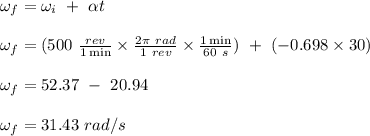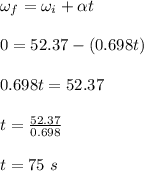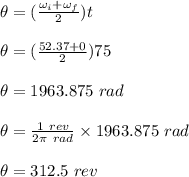
Physics, 19.11.2019 18:31 Jesseniapacheco31
Ahigh-speed flywheel in a motor is spinning at 500 rpm when a power failure suddenly occurs. the flywheel has mass 40.0 kg and diameter 75.0 cm. the power is off for 30.0 s, and during this time the flywheel slows due to friction in its axle bearings. during the time the power is off, the flywheel makes 200 complete revolutions.
(a) at what rate is the flywheel spinning when the power comes back on?
(b) how long after the beginning of the power failure would it have taken the flywheel to stop if the power had not come back on, and how many revolutions would the wheel have made during this time?

Answers: 1
Another question on Physics

Physics, 22.06.2019 00:00
Did the proton move into a region of higher potential or lower potential? did the proton move into a region of higher potential or lower potential? because the proton is a negative charge and it accelerates as it travels, it must be moving from a region of higher potential to a region of lower potential.because the proton is a negative charge and it accelerates as it travels, it must be moving from a region of lower potential to a region of higher potential.because the proton is a positive charge and it slows down as it travels, it must be moving from a region of higher potential to a region of lower potential.because the proton is a positive charge and it slows down as it travels, it must be moving from a region of lower potential to a region of higher potential.request answerpart bwhat was the potential difference that stopped the proton? express your answer with the appropriate units.î”v î” v = nothingnothingrequest answerpart cwhat was the initial kinetic energy of the proton, in electron volts? express your answer in electron volts.ki k i = nothing ev request answerprovide feedback
Answers: 2

Physics, 22.06.2019 04:30
In a voltaic cell, electrons flow from the (positive/negative) to the (positive/negative) terminal.
Answers: 1

Physics, 22.06.2019 16:00
An charge with mass m and charge q is emitted from the origin, (x,y)=(0,0). a large, flat screen is located at x=l. there is a target on the screen at y position y(h), where y(h) > 0. in this problem, you will examine two different ways that the charge might hit the target. ignore gravity in this problem. 1.assume that the charge is emitted with velocity v(0) in the positive x direction. between the origin and the screen, the charge travels through a constant electric field pointing in the positive y direction. what should the magnitude e of the electric field be if the charge is to hit the target on the screen? express your answer in terms of m, q, y(h), v(0), and l. 2.now assume that the charge is emitted with velocity v(0) in the positive y direction. between the origin and the screen, the charge travels through a constant electric field pointing in the positive x direction. what should the magnitude e of the electric field be if the charge is to hit the target on the screen? express your answer in terms of m, q, y(h), v(0), and l.
Answers: 1

Physics, 22.06.2019 20:30
Avehicle accelerates from 0 to 30 m/s in 10 seconds on a straight road
Answers: 2
You know the right answer?
Ahigh-speed flywheel in a motor is spinning at 500 rpm when a power failure suddenly occurs. the fly...
Questions


Physics, 05.03.2021 14:00


Biology, 05.03.2021 14:00

Mathematics, 05.03.2021 14:00

History, 05.03.2021 14:00

Social Studies, 05.03.2021 14:00




Social Studies, 05.03.2021 14:00

History, 05.03.2021 14:00








Mathematics, 05.03.2021 14:00

 = 500 rpmmass of the flywheel = 40 kgdiameter of the flywheel, d = 75 cmtime, t = 30 snumber of revolution of the flywheel, N = 200
= 500 rpmmass of the flywheel = 40 kgdiameter of the flywheel, d = 75 cmtime, t = 30 snumber of revolution of the flywheel, N = 200
























